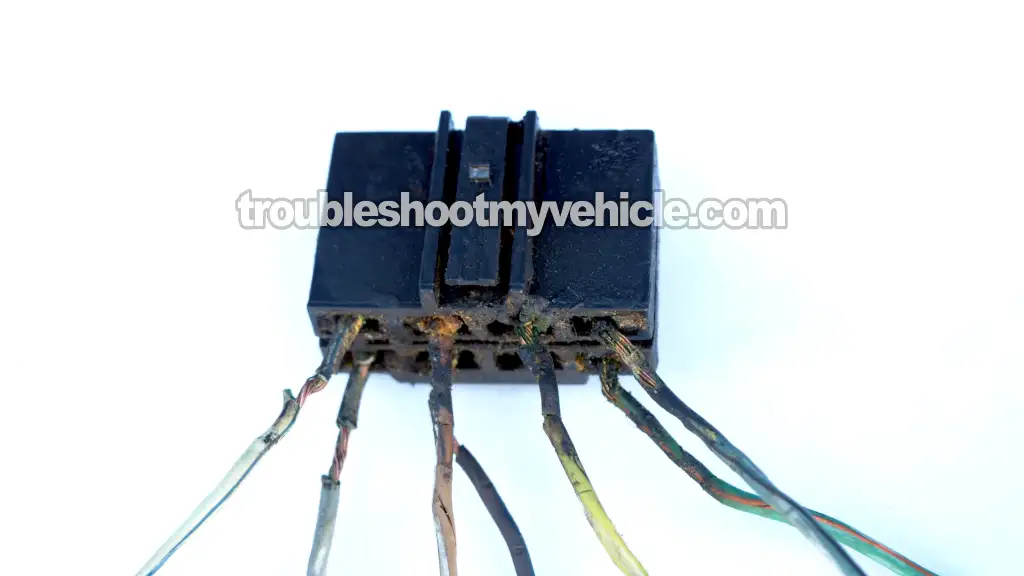
On the 1992–2000 3.0L V6 Dodge and Plymouth minivans, the fuel injectors are located under the intake plenum —which might make you think you'll have to remove the plenum to resistance test them with a multimeter.
The cool thing is that you do not need to remove the intake plenum to resistance test the fuel injectors on this engine.
In this tutorial, I'll show you how to easily test the injector resistance —so you can find out if a bad injector is causing a cylinder misfire or rough idle.
Contents of this tutorial:
APPLIES TO: This tutorial applies to the following vehicles:
- 3.0L V6 Dodge Caravan: 1992, 1993, 1994, 1995, 1996, 1997, 1998, 1999, 2000.
- 3.0L V6 Dodge Grand Caravan: 1992, 1993, 1994, 1995, 1996, 1997, 1998, 1999, 2000.
- 3.0L V6 Plymouth Voyager: 1992, 1993, 1994, 1995, 1996, 1997, 1998, 1999, 2000.
- 3.0L V6 Plymouth Grand Voyager: 1992, 1993, 1994, 1995, 1996, 1997, 1998, 1999, 2000.
WIRING DIAGRAM:
- Fuel Injector Circuit Wiring Diagram (1992-1993 3.0L V6 Dodge And Plymouth Minivan).
- Fuel Injector Circuit Wiring Diagram (1994-1995 3.0L V6 Dodge And Plymouth Minivan).
- Fuel Injector Circuit Wiring Diagram (1996-1997 3.0L V6 Dodge And Plymouth Minivan).
- Fuel Injector Circuit Wiring Diagram (1998-1999 3.0L V6 Dodge And Plymouth Minivan).
- Fuel Injector Circuit Wiring Diagram (2000 3.0L V6 Dodge And Plymouth Minivan).
CYLINDER MISFIRE DIAGNOSTICS:
FUEL INJECTOR SPRAY TEST:
Symptoms Of A Bad Fuel Injector
On the 3.0L V6 engine, fuel injectors typically fail in one of two ways:
- Electrical failure (open-circuit or shorted windings): If the injector's internal coil goes open or shorts out, that injector will stop working —no fuel gets sprayed into the cylinder.
- Restricted flow (partially clogged): A clogged injector might still spray fuel, but in a poor pattern or reduced volume —which throws off air/fuel mix and causes performance problems.
In some cases, the problem isn't the injector itself, but a damaged injector wiring connector, a harness fault, or a PCM driver that isn't delivering the correct signal to the injector.
Here are some of the most common symptoms of a bad or failing fuel injector on a 3.0L V6 minivan:
- Rough idle: Engine shakes or feels unstable at idle.
- Misfire: Acceleration may feel uneven or sluggish —if an injector is dead, one cylinder isn't firing.
- Misfire codes: On the 1996-2000 OBD II minivans, the PCM may store one or more of the following codes:
- P0300: Random misfire affecting multiple cylinders.
- P0301–P0306: These codes identify which specific cylinder is misfiring.
- Loss of power: A dead injector will cause a drop in engine performance and fuel economy.
- Lean condition codes: In some cases, you may also see a P0171 lean code (OBD II) if the overall fuel delivery is off.
8 Pin Fuel Injector Wiring Harness Connector Pinout

To test the resistance of the fuel injectors on your 3.0L V6 Dodge or Plymouth minivan, you'll be taking your measurements right at the 8-pin fuel injector wiring harness connector —specifically, the side with the male spade terminals.
Here are the terminal pin locations you'll be using to test each fuel injector:
| Pin | Description |
|---|---|
| 1 | Injector #1 |
| 2 | Injector #2 |
| 3 | Injector #3 |
| 4 | Injector #4 |
| 5 | 12 Volts (from ASD Relay) |
| 6 | Not Used |
| 7 | Injector #6 |
| 8 | Injector #5 |
TEST 1: Checking Fuel Injector Resistance
Inside every fuel injector is a small coil of wire (called a winding). When the injector receives 12 Volts and a Ground pulse from the PCM, that coil energizes —opening the injector and spraying fuel directly into the intake port.
Over time, that coil can fail. It might short internally or break (open-circuit). When this happens, the injector stops working —and that cylinder gets no fuel.
The good news is, you can easily check the condition of each injector's coil with a basic multimeter resistance test.
If you don't have a multimeter or need to upgrade yours? This is the one I use and recommend: Tekpower TP8268 AC/DC Auto/Manual Range Digital Multimeter (at: amazon.com).
NOTE: It's best to perform this test with the engine cold. Injector resistance specs are based on room temperature —but whatever your current ambient temp is, that's fine too as long as the engine is at the same ambient temp.
8-PIN CONNECTOR LOCATION: On the 3.0L V6 minivans, the fuel injector wiring harness 8-pin connector is located at the point where the ignition coil's 2-wire connector joins the main engine wiring harness —right on top of the rear valve cover (the one facing the firewall).
Here's how to do it:
- 1
Disconnect the 8-pin fuel injector wiring harness connector.
NOTE: All resistance tests are done at the connector with the male spade terminals —this is the one whose wires connect to the fuel injectors. - 2
Set your multimeter to Ohms (Ω) mode.
- 3
To test injector #1, probe terminals 1 and 5 with your meter leads.
NOTE: Refer to the connector pinout chart here: 8-pin Fuel Injector Wiring Harness Connector Pinout. - 4
To test injector #2, probe terminals 2 and 5.
- 5
To test injector #3, probe terminals 3 and 5.
- 6
To test injector #4, probe terminals 4 and 5.
- 7
To test injector #5, probe terminals 8 and 5.
- 8
To test injector #6, probe terminals 7 and 5.
- 9
Each injector should read between 10 and 16 Ohms.
Here's how to interpret your results:
CASE 1: All injectors test between 10–16 Ohms —That's a good result.
This means the internal coils are not shorted (0 Ohms) and not open (OL —open-circuit). All injectors are electrically sound.
Your next step is to check injector spray. Go here:
CASE 2: One or more injectors read outside 10–16 Ohms —That injector has failed the test.
The coil is weak or failing —replacement is recommended.
CASE 3: One or more injectors show an open-circuit (OL) —The coil is open —this injector is completely dead.
Replacing the failed injector will resolve the cylinder misfire caused by this problem.
Dry-Rotted Wiring At The Fuel Injector Harness Connector

One very common problem on the 1992–2000 3.0L V6 Dodge and Plymouth minivans —and one that can stop the injectors from working and prevent the engine from starting— is dry-rotted, shorted wiring in the injector harness, specifically in the section of wiring where the wires exit the rear of the 8-pin connector (see photo above).
This problem affects both sides of the connector —whether it's the section going to the fuel injectors or the section going into the main engine wiring harness— right where the wires enter the connector, they're vulnerable to dry-rot from engine oil exposure.
Here's why: those sections of wiring aren't protected by a hard plastic wire loom, and the wires are exposed right where they enter the 8-pin injector harness connector. Over the years, this area often gets soaked in engine oil (from leaking valve cover gaskets), which begins to attack the insulation.
That oil, combined with engine heat, causes the insulation to break down (a process called plasticizer migration). Eventually, the insulation starts to dry-rot, crack, and peel away —exposing the bare copper underneath.
In time, those exposed copper wires can short together —cutting off the PCM's injector pulse signal. In some cases, this can also blow the fuse that powers the ASD relay— leaving you with an engine that cranks but won't start at all.
This is exactly why —when you're testing injector resistance at the 8-pin connector— it's a good idea to inspect the wires coming out of the connector. I always use a small flashlight to check— looking for any sign that copper is showing through the insulation.
If you spot peeling or missing insulation, you've found a problem that needs to be addressed right away.
Now for the bad news: new replacement injector harnesses for these vans are no longer available —they just aren't being made anymore. So if your harness is damaged, here are your options:
- Find a good-condition used harness from a salvage yard and install it.
- Repair your existing harness —this means de-pinning the connector and splicing in new wire sections where needed. You'll need a terminal removal tool to do this right.
- Retrofit with a different connector —many folks now use a 14-pin connector from a 2.4L or 3.3L/3.8L minivan. You only need 6 injector wires, so the extra terminals are left unused. This has become the go-to fix when a clean original connector can't be sourced.
Whichever option you choose —this is not a problem to ignore. If you find dry-rotted wiring on the injector harness, it can and will cause misfires, hard starts, or a no-start condition if left alone.
More 3.0L V6 Dodge And Plymouth Minivan Tutorials
I've written several more tutorials for the V6 Dodge and Plymouth minivans that you might find helpful. You can browse them all in this index:
Here's a sample of the tutorials you'll find in the index:
- How To Replace The Distributor (1988-2000 3.0L V6 Chrysler, Dodge, Plymouth).
- How To Test For A Broken Timing Belt (1988-2000 3.0L SOHC Chrysler).
- How To Test The Cam Sensor (1996-2000 3.0L Caravan, Grand Caravan, Voyager, Grand Voyager).
- How To Test An Engine No-Start (1990-2000 3.0L V6 Chrysler, Dodge, And Plymouth Minivan).

If this info saved the day, buy me a beer!


